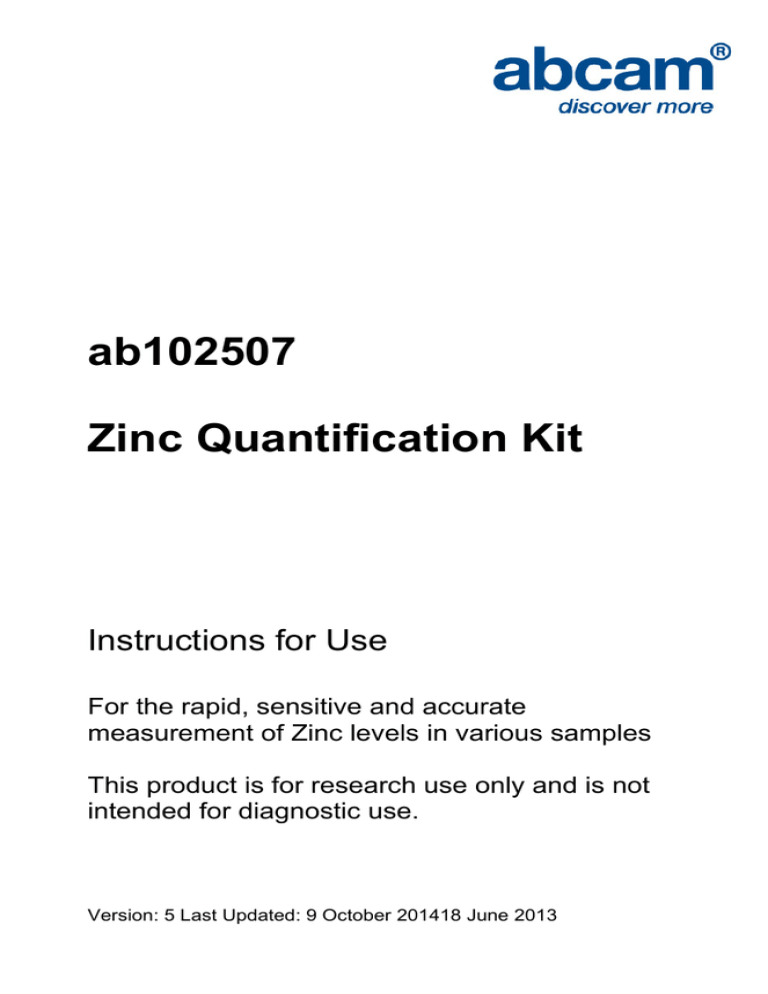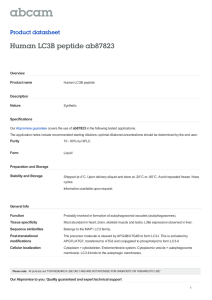
ab102507
Zinc Quantification Kit
Instructions for Use
For the rapid, sensitive and accurate
measurement of Zinc levels in various samples
This product is for research use only and is not
intended for diagnostic use.
Version: 5 Last Updated: 9 October 201418 June 2013
1
Table of Contents
Table of Contents
2
1.
Overview
2
2.
Protocol Summary
4
3.
Materials Supplied
5
4.
Storage and Stability
5
5.
Materials Required, Not Supplied
6
6.
Assay Protocol
7
7.
Data Analysis
9
8.
Troubleshooting
11
2
1. Overview
Zinc, a metallic chemical element, symbol Zn and atomic number 30
is chemically similar to Magnesium due to its similar size and sole
oxidation state of
2+.
Zinc is an essential mineral of great biological
significance, because many enzymes require it as an essential
cofactor.
Examples of zinc’s biological roles include signal transduction, gene
expression, and regulation of apoptosis, synaptic plasticity and
prostate gland function.
Abcam’s Zinc Quantification Kit is a convenient colorimetric assay in
which Zinc binds to a ligand that will developed and detected at an
absorbance at OD560 nm. The assay can be used with biological
samples such as serum, plasma, CSF or urine with detection
sensitivity 0.2 µg/ml (~1 – 3 µM).
3
2. Protocol Summary
Sample Preparation
Standard Curve Preparation
Prepare and Add Reaction Mix
Measure Optical Density
4
3. Materials Supplied
Item
Quantity
Zinc Reagent 1
16 mL
Zinc Reagent 2
4 mL
7% TCA
5 mL
Zinc Standard (50 mM)
100 µL
4. Storage and Stability
Upon arrival, store the kit at +4°C and protected from light.
Read the entire protocol before performing the assay.
The reagents are ready to use as supplied.
Synthetic rubber and glass can contain zinc which may leach
into samples. For highest accuracy all glassware should be
washed with dilute HCl, rinsed with distilled water and dried
prior to use.
5
Sample tubes such as Vacutainer® and similar devices should
be sealed with Parafilm® rather than the butyl rubber stopper.
Chelators such as EDTA will give artificially low zinc levels
and should be avoided in lysis buffers for all samples. For
blood samples, heparin, citrate and oxalate are acceptable
anticoagulants.
Most blood zinc (80%) is contained in erythrocytes and
hemolysis will release large amounts into the serum.
Abnormally high serum values obtained suggest the collection
of another sample and re-testing.
5. Materials Required, Not Supplied
Distilled water or MilliQ
Microcentrifuge
Pipettes and pipette tips
Colorimetric microplate reader
96 well plate
Orbital shaker
6
(Optional): HCl, for urine samples
7
6. Assay Protocol
1. Sample Preparation:
a) Cell
lysates
and
tissue
extracts:
harvest
cells
or
homogenize tissue with an EDTA-free lysis buffer. Spin down
to get rid of cell debris and transfer supernatant to clean
tubes.
Lysates generally contain significant amounts of protein, so
they should be deproteinized by adding 50 µl of the 7% TCA
solution per 50 µl of the sample (add 1x volume TCA to 1x
volume sample).
Spin lysates-TCA mix at top speed for 5 minutes.
Add 20 – 50 µl of sample to a 96-well plate; if volume of cell is
< 50 µl, bring the volume to 50 µl/well with dH2O.
b) Urine samples: urine samples should be acidified to pH 3 – 4
to dissolve any sediment that could bind to zinc. Add 1 – 2
drops of concentrated HCl per 15 ml sample.
Acidified urine can be used directly in the assay (20 – 50 µl
sample/well).
c) Other liquid samples (Cell culture media, plasma, serum
and other biological fluids): liquid samples can be assayed
directly. However, samples that contain significant amounts of
protein such as serum, plasma and CSF should be
deproteinized prior the assay.
8
Add 1x volume of the 7% TCA solution to 1x volume of sample
(for example, 50 µl of 7% TCA to 50 µl of sample).
Spin sample-TCA mix at at top speed for 5 minutes.
Add 20-50 μl of the sample(s) to a 96 well plate; if volume of cells
is < 50 µl, bring the volume to 50 μl/well with dH2O.
For unknown samples, we suggest including several dilutions for
each sample so that the reading will be within the standard curve
range.
2. Standard Curve Preparation:
Prepare a 0.5mM Zinc Standard by adding 10 μl of the 50 mM
Zinc Standard to 990 μl of dH2O and mixing well.
Add 0, 2, 4, 6, 8, 10 μl into a series of wells. Adjust volume to 50
μl/well with dH2O to generate 0, 1, 2, 3, 4, 5 nmol/well of the Zinc
Standard.
3. Reaction Mix:
Add 4x parts of Zinc Reagent 1 to 1x part Zinc Reagent 2. Make
only as much Zinc reaction mix as is needed for samples and
standards to be run. Each sample or standard requires 200 μl of
reagent mix. Once mixed, the Zinc reaction mix is good for 2
days at room temperature or 1 week at +4°C.
Add 200 μl of Zinc reaction mix to each standard and sample;
incubate 10 min at room temperature.
9
4. Measurement:
Measure assay at OD560nm in a microplate reader.
7. Data Analysis
Correct background by subtracting the value derived from the zero
Zinc Standard from all readings. The background reading can be
significant and must be subtracted.
Plot the Zinc Standard curve.
Read Zinc sample concentrations from the standard curve:
Concentration = Sa / Sv nmol/μl or mM,
Where
Sa is the sample amount (in nmol) from standard curve
Sv is the sample volume (μl) added into the wells
Zinc MW: 65.384 g/mol
10
11
8. Troubleshooting
Problem
Reason
Solution
Assay not
working
Assay buffer at
wrong temperature
Assay buffer must not be chilled
- needs to be at RT
Protocol step missed
Plate read at
incorrect wavelength
Unsuitable microtiter
plate for assay
Unexpected
results
Re-read and follow the protocol
exactly
Ensure you are using
appropriate reader and filter
settings (refer to datasheet)
Fluorescence: Black plates
(clear bottoms);
Luminescence: White plates;
Colorimetry: Clear plates.
If critical, datasheet will indicate
whether to use flat- or U-shaped
wells
Measured at wrong
wavelength
Use appropriate reader and filter
settings described in datasheet
Samples contain
impeding substances
Unsuitable sample
type
Troubleshoot and also consider
deproteinizing samples
Use recommended samples
types as listed on the datasheet
Sample readings are
outside linear range
Concentrate/ dilute samples to
be in linear range
12
Samples
with
inconsistent
readings
Unsuitable sample
type
Samples prepared in
the wrong buffer
Samples not
deproteinized (if
indicated on
datasheet)
Cell/ tissue samples
not sufficiently
homogenized
Too many freezethaw cycles
Samples contain
impeding substances
Samples are too old
or incorrectly stored
Lower/
Higher
readings in
samples
and
standards
Not fully thawed kit
components
Out-of-date kit or
incorrectly stored
reagents
Reagents sitting for
extended periods on
ice
Refer to datasheet for details
about incompatible samples
Use the assay buffer provided
(or refer to datasheet for
instructions)
Use the 10kDa spin column
(ab93349)
Increase sonication time/
number of strokes with the
Dounce homogenizer
Aliquot samples to reduce the
number of freeze-thaw cycles
Troubleshoot and also consider
deproteinizing samples
Use freshly made samples and
store at recommended
temperature until use
Wait for components to thaw
completely and gently mix prior
use
Always check expiry date and
store kit components as
recommended on the datasheet
Try to prepare a fresh reaction
mix prior to each use
Incorrect incubation
time/ temperature
Refer to datasheet for
recommended incubation time
and/ or temperature
Incorrect amounts
used
Check pipette is calibrated
correctly (always use smallest
volume pipette that can pipette
entire volume)
13
Problem
Reason
Solution
Standard
curve is not
linear
Not fully thawed kit
components
Wait for components to thaw
completely and gently mix prior
use
Pipetting errors when
setting up the
standard curve
Incorrect pipetting
when preparing the
reaction mix
Try not to pipette too small
volumes
Always prepare a master mix
Concentration of
standard stock
incorrect
Air bubbles will interfere with
readings; try to avoid producing
air bubbles and always remove
bubbles prior to reading plates
Recheck datasheet for
recommended concentrations of
standard stocks
Errors in standard
curve calculations
Refer to datasheet and re-check
the calculations
Use of other
reagents than those
provided with the kit
Use fresh components from the
same kit
Air bubbles in wells
For further technical questions please do not hesitate to
contact us by email (technical@abcam.com) or phone (select
“contact us” on www.abcam.com for the phone number for
your region).
14
15
UK, EU and ROW
Email: technical@abcam.com | Tel: +44(0)1223-696000
Austria
Email: wissenschaftlicherdienst@abcam.com | Tel: 019-288-259
France
Email: supportscientifique@abcam.com | Tel: 01-46-94-62-96
Germany
Email: wissenschaftlicherdienst@abcam.com | Tel: 030-896-779-154
Spain
Email: soportecientifico@abcam.com | Tel: 911-146-554
Switzerland
Email: technical@abcam.com
Tel (Deutsch): 0435-016-424 | Tel (Français): 0615-000-530
US and Latin America
Email: us.technical@abcam.com | Tel: 888-77-ABCAM (22226)
Canada
Email: ca.technical@abcam.com | Tel: 877-749-8807
China and Asia Pacific
Email: hk.technical@abcam.com | Tel: 108008523689 (中國聯通)
Japan
Email: technical@abcam.co.jp | Tel: +81-(0)3-6231-0940
www.abcam.com | www.abcam.cn | www.abcam.co.jp
Copyright © 2014 Abcam, All Rights Reserved. The Abcam logo is a registered trademark.
16
All information / detail is correct at time of going to print.
Copyright © 2013 Abcam, All Rights Reserved. The Abcam logo is a registered trademark.
All information / detail is correct at time of going to print.


![Anti-DR4 antibody [B-N28] ab59481 Product datasheet Overview Product name](http://s2.studylib.net/store/data/012243732_1-814f8e7937583497bf6c17c5045207f8-300x300.png)

